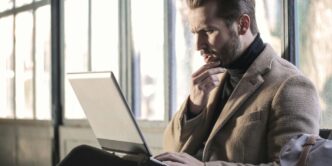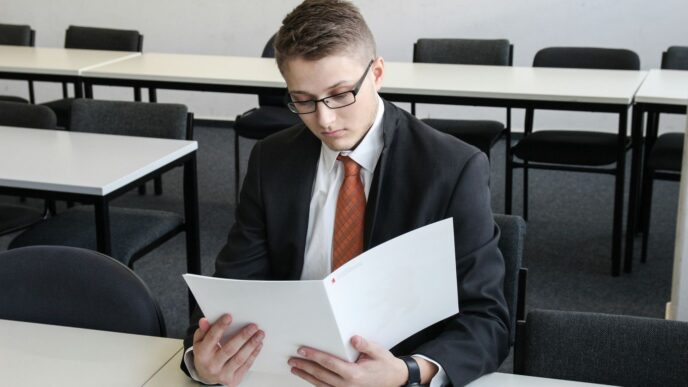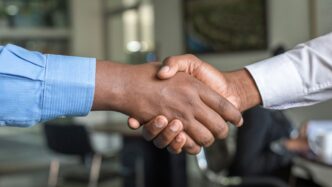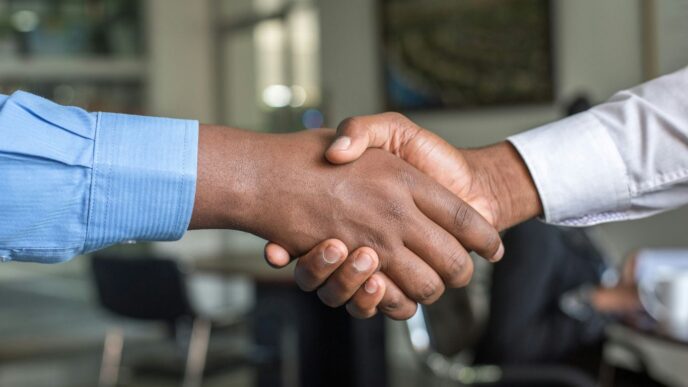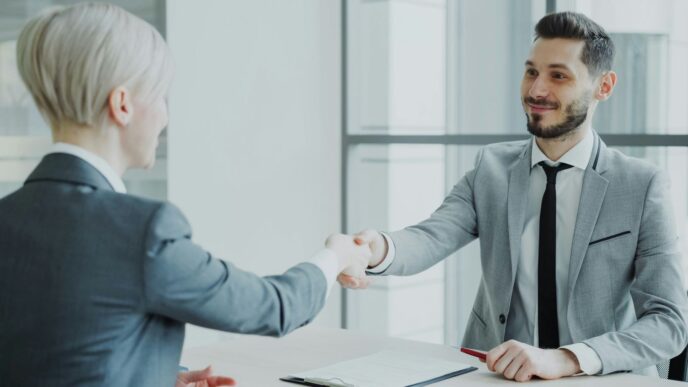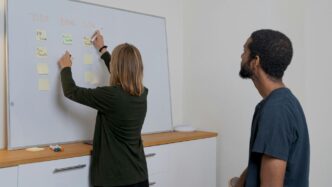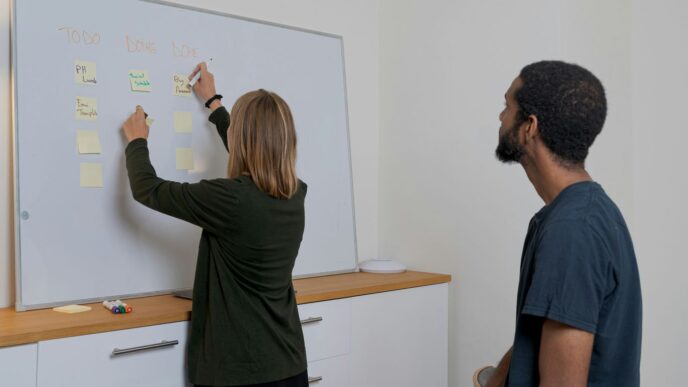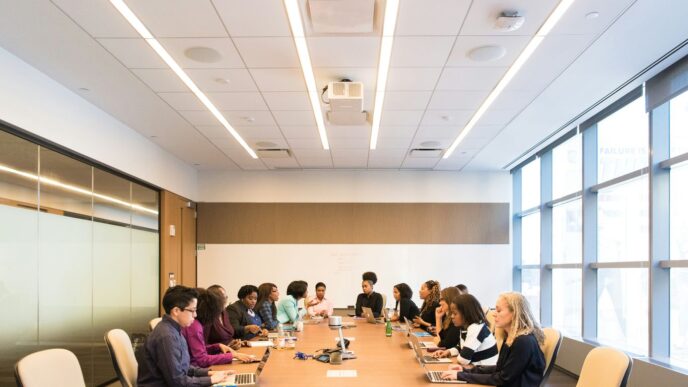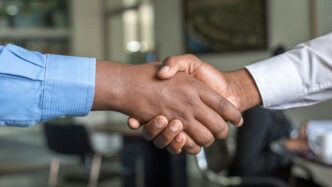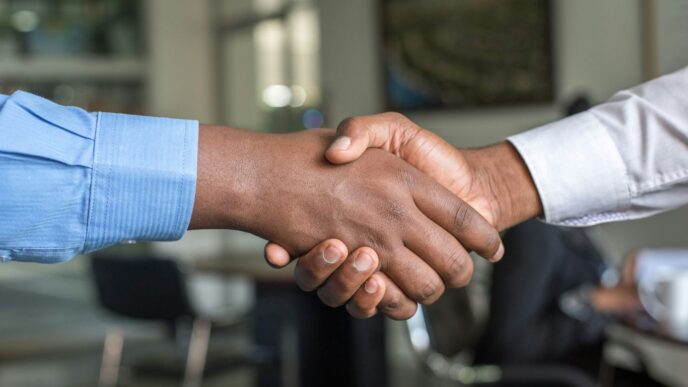Getting ready for a job interview? What you wear really matters. It’s not just about looking nice; it’s about showing you’re serious and you fit in. This guide will help you pick out the perfect interview suit so you can walk in feeling great and make a super first impression. We’ll cover everything from figuring out what the company expects to choosing the right shoes.
Key Takeaways
- Always research the company’s vibe before picking your interview suit.
- Know the difference between business casual and business formal.
- Choose a suit or pantsuit that fits well and is comfortable.
- Keep accessories simple and classic; don’t overdo it.
- Avoid wrinkled clothes, uncomfortable shoes, and anything too flashy.
Researching Company Culture
Before you even think about what tie to wear or if your shoes are shiny enough, you gotta figure out what kind of place you’re interviewing at. Seriously, knowing the company’s vibe is half the battle when it comes to picking out your interview outfit. You don’t want to show up in a three-piece suit if everyone else is in jeans and a t-shirt, right? Or worse, the other way around. Getting a feel for the company’s culture helps you pick an outfit that fits in, showing you’ve done your homework and you’re a good match. It’s not just about looking good; it’s about looking like you belong.
Investigating Company Websites
So, where do you start? The company’s own website is a goldmine, believe it or not. It’s not just for job listings. You want to dig around a bit. Look for sections like "About Us," "Our Team," or "Life at [Company Name]."
- Check out the photos. Are people in suits? Business casual? Super laid-back?
- Read their mission statement and values. Do they talk about innovation and creativity, or tradition and formality?
- See if they have a blog or news section. What kind of events do they highlight? Are they all serious conferences, or do they show off team-building picnics?
All these little clues add up to a bigger picture of what the company is all about and, more importantly, what their employees typically wear. It’s like being a detective, but for clothes.
Leveraging Social Media Insights
After you’ve scoured the official website, jump over to social media. This is where you often get a more unfiltered look at the company’s day-to-day. LinkedIn is a big one, obviously, but don’t forget Instagram, Facebook, or even TikTok if they’re on it.
- Look for candid photos from company events, holiday parties, or even just everyday office life. People tend to dress more naturally in these shots than in official headshots.
- Pay attention to employee posts. Sometimes, employees share their own photos or talk about the office environment, which can give you even more insight.
- See how they interact with their followers. Is their tone formal and corporate, or more casual and friendly? This can tell you a lot about their overall culture.
Social media can really show you the real deal, beyond the polished corporate image. It’s like peeking behind the curtain.
Considering the Type of Business
Finally, think about the industry itself. Different types of businesses just have different dress codes, it’s a fact of life. A law firm is probably going to be more formal than a tech startup, right?
- Finance and Law: These are usually pretty buttoned-up. Think suits, ties, and formal dresses.
- Tech and Creative: Often much more relaxed. Business casual is common, and sometimes even smart casual is fine. You might see jeans, but usually nice ones.
- Healthcare: This can vary. Some roles require scrubs, others professional attire. Always check for specific guidelines.
Knowing the general expectations for the industry can help you narrow down your choices. For example, AI in recruitment companies might have a different vibe than a traditional manufacturing firm. It’s all about fitting in, but still showing off your own style. You want to look like you understand the environment you’re stepping into, and that you’re ready to be a part of it.
Understanding Business Attire Styles
Once you’ve got a handle on the company’s vibe, the next step is figuring out what kind of business attire you’re actually looking at. It’s not always as simple as it sounds, right? Knowing the difference between business casual and business formal is pretty important for picking out your interview outfit. You want to make sure you’re not showing up in a full suit when everyone else is in jeans, or vice versa. It’s all about making a good first impression, and your clothes play a big part in that.
Defining Business Casual
Business casual is probably the most common dress code you’ll run into these days. It’s that sweet spot between super relaxed and super formal. Think neat, polished, but still comfortable. It’s about looking professional without being overly stiff. For guys, this usually means slacks or khakis, a collared shirt (like a polo or a button-down), and maybe a sweater or a sport coat. No ties needed here. For women, it could be dress pants, a skirt (knee-length or longer), blouses, sweaters, or even a nice dress. The key is avoiding anything too revealing, too flashy, or too casual like t-shirts, ripped jeans, or sneakers. It’s about looking put-together and ready for work, but not like you’re heading to a black-tie event. It’s a pretty flexible category, which can sometimes make it tricky to get just right.
Exploring Business Formal
Now, business formal is a whole different ballgame. This is when you pull out all the stops and go for that classic, polished look. We’re talking suits, folks. For men, it’s a matching suit jacket and trousers, a dress shirt, a tie, and dress shoes. Darker colors like navy, charcoal, or black are usually the way to go. For women, it’s a pantsuit or a skirt suit, a professional blouse, and closed-toe dress shoes. The skirt should be at least knee-length. This is the kind of attire you’d see in more traditional industries like law, finance, or some corporate settings. It shows you’re serious, respectful, and ready for a high-stakes environment. Think about it: if you’re interviewing for a leadership position, you’ll definitely want to lean towards business formal.
When to Wear Business Casual Clothes
So, when is business casual the right choice? Well, it really depends on the company and the role. Many tech companies, creative agencies, and even some startups have embraced a more relaxed dress code. If the company culture seems laid-back, or if the job itself isn’t client-facing in a formal way, business casual is probably your best bet. Here are some situations where business casual is often appropriate:
- Interviews at companies with a modern, less traditional culture.
- Roles that don’t involve frequent formal client meetings.
- When the job description or company website hints at a relaxed environment.
- If you’ve done your research and seen employees dressed in business casual attire.
Selecting Your Interview Suit Components
Choosing the Right Suit or Pantsuit
Alright, so you’re trying to figure out what to wear for that big interview. The suit or pantsuit is usually the main event, right? It’s what people notice first. You want something that says "I’m serious about this, and I pay attention to details." For men, a classic two-piece suit in a dark neutral color like charcoal gray or navy blue is always a safe bet. Black can work too, but sometimes it feels a little too formal, like you’re going to a funeral or something. For women, a well-tailored pantsuit or a skirt suit (skirt should hit around the knee) in similar neutral tones is perfect. The fabric matters too; wool blends usually look the most professional and hold their shape well. Avoid anything too shiny or with a loud pattern. You’re not trying to be a peacock, just a professional. Think about the company culture you researched earlier; if it’s super traditional, lean more formal. If it’s a bit more relaxed, you might get away with a slightly less rigid fabric, but still keep it sharp. Remember, the goal is to look put-together and competent, not to make a fashion statement.
Picking Appropriate Shirts
Okay, so you’ve got the suit, now what goes underneath? This is where you can add a little bit of personality, but still keep it professional. For men, a crisp, long-sleeved dress shirt is the way to go. White or light blue are classic choices and always look clean. You want to make sure it’s ironed, no wrinkles allowed! The collar should fit well, not too tight or too loose. For women, a blouse or a shell top works great. Again, stick to solid, neutral colors like white, cream, light blue, or even a soft pastel. Avoid anything with a busy pattern, low-cut necklines, or sheer fabrics. You want to look polished, not like you’re going out for drinks. The fabric should be breathable and not prone to wrinkling easily. Think about how it will look under your suit jacket – you don’t want any weird bulges or bunching. It’s all about looking smooth and effortless, even if you spent an hour getting ready.
Footwear That Makes an Impression
Now, let’s talk about your feet. Seriously, people notice shoes! You might think they don’t, but a scuffed pair of shoes can totally ruin an otherwise perfect outfit. For men, polished leather dress shoes are a must. Think oxfords or loafers in black or dark brown. Make sure they’re clean and shined – seriously, take a minute to wipe them down. No sneakers, no sandals, no exceptions. For women, closed-toe pumps or low heels are generally the best choice. Again, stick to neutral colors like black, navy, or nude. The heel height should be comfortable enough for you to walk confidently and not wobble around. Avoid open-toed shoes, overly high heels, or anything too flashy. Comfort is key here, because you might be doing a lot of walking or standing. You don’t want to be distracted by aching feet during your interview. A good pair of shoes can really tie the whole look together and show that you pay attention to the details, which is a good trait for any assessing the worth of a business.
Accessorizing Your Interview Suit
Accessories might seem like small details, but they can really pull your whole interview look together. Think of them as the finishing touches that show you pay attention to the little things. You want to pick items that complement your outfit without stealing the show. The goal is to look polished and professional, not like you’re heading to a party.
Subtle Jewelry Choices
When it comes to jewelry, less is definitely more for an interview. You’re aiming for subtle elegance, not flashy statements. The right jewelry can add a touch of sophistication without distracting from your qualifications.
- Keep necklaces simple, like a delicate chain with a small pendant.
- For earrings, studs or small hoops are perfect. Avoid anything dangly or too large.
- Rings should be minimal; one or two simple bands are fine. Skip anything chunky or overly ornate.
- Bracelets should be understated and not make noise when you move your arm. A thin chain or a simple bangle works well.
The Importance of a Watch
A watch isn’t just for telling time anymore; it’s a classic accessory that speaks volumes about your professionalism and attention to detail. It shows you’re punctual and organized. Plus, checking your phone for the time during an interview can look a bit rude, so a watch is a practical choice.
Consider these watch styles:
- Classic Analog: A traditional watch with a leather strap or a metal band in silver or gold. This is always a safe bet.
- Minimalist: Clean lines, simple face, and no extra bells and whistles. This style is sleek and modern.
- Smartwatch (Subtle): If you wear a smartwatch, make sure it’s not too bulky or brightly colored. Turn off notifications so it doesn’t buzz during the interview. You want it to blend in, not stand out.
Ties and Other Details
For those wearing a tie, it’s another chance to add a touch of personality while maintaining professionalism. Your tie should complement your suit and shirt, not clash with them. Think about the overall groom’s suit presentation.
- Tie Color and Pattern: Stick to conservative colors like navy, burgundy, or dark green. Small, subtle patterns like stripes or dots are fine, but avoid anything too loud or cartoonish.
- Tie Length: The tip of your tie should just barely touch the top of your belt buckle. Too long or too short looks sloppy.
- Tie Knot: A simple knot like a four-in-hand or a half-Windsor is appropriate. Make sure it’s neat and tight.
- Pocket Square: If you choose to wear one, it should be a subtle accent, not a focal point. A simple white or complementary color folded neatly is best.
- Belt: Your belt should match your shoes in color and finish. A simple leather belt is always a good choice.
- Socks: Make sure your socks are long enough so no skin shows when you sit down. They should also match your pants or shoes in color.
Ensuring the Perfect Fit and Comfort

Prioritizing Comfort for Confidence
When you’re heading into an interview, the last thing you want is to be fidgeting with your clothes. Feeling comfortable in your outfit is a big deal because it lets you focus on the conversation, not on how tight your collar is or if your pants are bunching up. If you’re constantly adjusting, it can make you look distracted or even a little bit unsure of yourself. Think about it: if you’re not at ease, it’s hard to project confidence. So, before you even think about style, make sure whatever you pick out allows you to sit, stand, and move around without any hassle. This means no itchy fabrics, no restrictive waistbands, and definitely no shoes that pinch your toes. Your comfort directly impacts your ability to perform well.
Achieving the Right Fit
Getting the fit just right is probably the most important part of looking polished. An ill-fitting suit, whether it’s too big or too small, can completely undermine your professional image. It’s not about wearing the most expensive brand; it’s about wearing clothes that look like they were made for you. Here’s what to keep in mind:
- Shoulder Seams: For jackets, the shoulder seams should line up perfectly with your actual shoulders. If they hang off or pull tight, the jacket isn’t the right size.
- Sleeve Length: Jacket sleeves should end right at your wrist bone, allowing about a quarter to half an inch of your shirt cuff to show. Shirt sleeves should hit just where your hand begins.
- Pants Length: Your trousers should have a slight break (a small crease) at the top of your shoes. No puddling at the ankles, and no high-waters!
- Waistline: Your pants or skirt should fit comfortably at your natural waist without needing a belt to hold them up, but also not digging in.
If you’re unsure, consider visiting a tailor. A small investment in alterations can make an off-the-rack suit look custom-made, which really makes a difference. For example, a well-fitted pair of polo shirts can also make a casual outfit look sharp.
Neutral Colors for a Polished Look
When it comes to color, neutral tones are your best friend for an interview. They convey professionalism, seriousness, and don’t distract from what you’re saying. Bright, flashy colors can be fun for other occasions, but for an interview, they might send the wrong message. Stick to the classics:
- Navy Blue: This is a fantastic alternative to black. It’s professional, versatile, and often seen as more approachable than stark black.
- Charcoal Gray: Another excellent choice, charcoal gray is sophisticated and works well with a variety of shirt and accessory colors.
- Black: Always a safe bet, especially for more formal environments. Just make sure it’s a true black and not faded.
- White/Light Blue: For shirts, these are the go-to colors. They’re clean, crisp, and universally accepted as professional.
Using neutral colors allows the interviewer to focus on your qualifications and personality, rather than being distracted by your attire. It shows you understand the importance of presenting yourself appropriately for a serious professional setting.
Avoiding Common Interview Suit Mistakes
Steering Clear of Wrinkled Attire
Nobody wants to show up to an interview looking like they just rolled out of bed, right? Wrinkles on your suit or shirt can really send the wrong message. It tells the interviewer that you might not pay attention to details, or worse, that you don’t really care about making a good impression. Always make sure your interview clothes are pressed and wrinkle-free before you head out the door. It’s a small thing, but it makes a huge difference. Think about it: if you can’t even manage to iron your clothes, how are you going to handle the responsibilities of a new job?
Avoiding Inappropriate Footwear
Your shoes are just as important as your suit. Seriously! You might think nobody notices, but they do. Wearing the wrong kind of shoes can totally throw off your whole look and make you seem less professional. Here’s a quick rundown of what to avoid and what to aim for:
- Open-toed shoes: Big no-no. This includes sandals, flip-flops, or anything that shows your toes. It’s just too casual for an interview setting.
- Dirty or scuffed shoes: Even if they’re the right style, if they look like they’ve been through a mud wrestling match, it’s not good. Give them a good polish or wipe down.
- Athletic sneakers: Unless you’re interviewing to be a personal trainer, leave the running shoes at home. They don’t belong with a suit.
- Overly flashy shoes: While you want to look good, shoes with excessive buckles, bright colors, or crazy patterns can be distracting. Stick to classic, understated styles.
- Uncomfortable shoes: If you’re fidgeting because your feet hurt, it’ll show. Make sure your shoes are comfortable enough to walk and stand in without pain.
Dressing for the Specific Role
This is where a little research really pays off. What you wear should align with the company culture and the specific job you’re applying for. You wouldn’t wear the same thing to an interview at a tech startup as you would to a law firm, would you? Overdressing can sometimes make you seem out of touch, while underdressing can make you look like you don’t take the opportunity seriously. It’s a balancing act. For example, if you’re interviewing for a creative role, you might have a bit more leeway with your fabric quality and color choices, but for a corporate position, sticking to traditional business attire is usually the safest bet. Always try to match the vibe of the place you’re hoping to work at.
Wrapping Things Up
So, we’ve talked a lot about what to wear for an interview, and honestly, it’s pretty clear that your clothes matter more than just covering you up. Think of your outfit as a way to show who you are and what you can bring to a company. When you look put-together and ready, it tells them you’re serious and you want to do well. So, take a little time to pick out your clothes, and don’t forget the small stuff like colors, how it fits, and any little extras you wear.
Frequently Asked Questions
What kind of clothes should I wear for a job interview?
For most job interviews, it’s best to choose clothes that are simple and neat. This means wearing a suit or a nice outfit that shows you are serious about the job.
How can I find out what to wear for a company’s interview?
When you’re trying to figure out what to wear, look at the company’s website. See how people in their pictures are dressed. You can also check out their social media to get a sense of the workplace style.
What makes an interview outfit good?
A good interview outfit should be clean, fit well, and be comfortable. Pick colors that are not too bright, like black, gray, or navy blue. Make sure your shoes are clean and polished.
Is it better to overdress or underdress for an interview?
It’s usually better to dress a little bit nicer than too casual. If you’re not sure, a suit or a nice dress is a safe bet. It shows you respect the company and the interview process.
Should I wear accessories with my interview outfit?
Yes, accessories like a simple watch, small earrings, or a plain necklace can make your outfit look better. Just don’t wear anything too big or shiny that might distract the interviewer.
What should I avoid wearing to a job interview?
Always make sure your clothes are clean and ironed. Avoid anything with holes or stains. Also, don’t wear shoes that are too casual, like sneakers or flip-flops.

